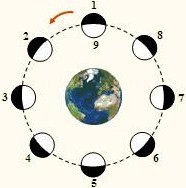The Moon is a small satellite of the Earth, constantly looking around the middle of it, really makes is to turn around the planet. It is very close to us and that is why there is mutual interaction between Earth-moon.
We always see the same face of the Moon because the Moon takes the same rotate once about herself that in giving a return around the Earth, a little more than 27 days. The result is that it always points towards us the same part of our satellite.

Here we can see the what happens to the moon an why we always see the same part of the moon on it.
Sunni







